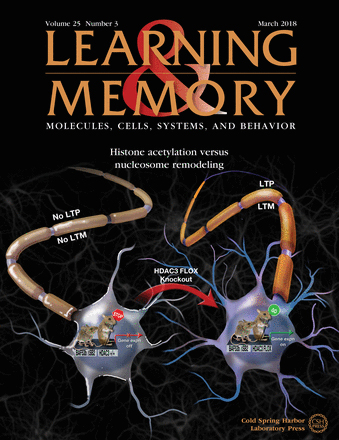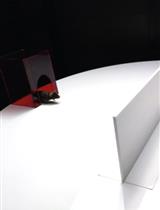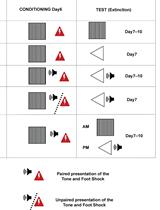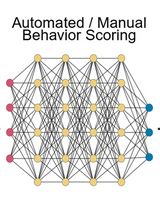- EN - English
- CN - 中文
A Modified Barnes Maze for Juvenile Rats
一种改进的用于幼年大鼠的巴恩斯迷宫
发布: 2018年11月20日第8卷第22期 DOI: 10.21769/BioProtoc.3084 浏览次数: 6450
评审: Karen N KrukowskiAnonymous reviewer(s)
Abstract
To better understand neural codes for spatial navigation and to address cognitive development questions, the neurobiology of postnatal hippocampal development is receiving increased attention. While the Morris Water Maze is the gold standard for assessing hippocampal integrity, potential confounds can be difficult to control for in juvenile rodents (around three weeks of age, when spatial navigation ability first emerges) and this wet maze is not amenable to electrophysiological recording. A dry maze alternative with minimal training, like the Barnes Maze adapted for juvenile rats, can help overcome these obstacles. This paper describes in detail the experimental procedure and data analyses for the adapted Barnes maze for juvenile animals.
Keywords: Barnes maze (巴恩斯迷宫)Background
The Barnes maze (Barnes, 1979) is a widely acknowledged dry alternative to the Morris Water Maze (MWM) (Morris, 1984). The Barnes maze uses bright light as a motivating factor to cause animals to locate a darkened box hidden beneath one of several escape holes using spatial cues. It has recently been shown that a Barnes maze adapted for juvenile rats can be used to assess the maturation of spatial learning and memory, as spatial navigation ability first emerges around the end of the third postnatal week (McHail et al., 2018). Unlike the MWM, the Barnes maze requires less time away from the dam and does not involve swimming and temperature stressors that can differentially impact juvenile animals (Albani et al., 2014). Also, the Barnes maze is more compatible with in vivo electrophysiological recording, enabling a greater signal to noise ratio (McHail et al., 2018).
The Barnes maze adapted for juvenile rats consists of a round white platform that is smaller than the adult maze with eight evenly spaced holes around the perimeter, a reduced number of perimeter holes compared to the adult apparatus. Distal visual cues (extra-maze contextual cues) are placed around the maze and used by the animal to determine the spatial location of an escape box hidden underneath one of the perimeter holes. These spatial cues are enlarged to allow better visualization for the younger animals (McHail et al., 2018).
Behavioral testing consists of four days: an exploration trial on Day 1, 5 blocks of training trials followed by a spatial learning probe on Days 2 and 3, and a final spatial memory probe approximately 24 h later (24 HP). The exploration trial on Day 1 allows the animal to freely roam the platform in dim lighting (no escape box) and permits the experimenter to map place cells in animals having tetrodes implanted. Soy-based infant formula droplets are scattered on the maze to encourage exploration. Training on Days 2 and 3 are conducted under bright lighting with the escape box positioned under the same escape hole for all training trials. Each block contains four trials where the animal has a maximum of 60 s to locate the goal starting from four different start locations that are randomly ordered within a block. Training blocks are separated by 15-30 min. Following the final block on each training day, a probe is conducted wherein the escape box is removed and the animal is observed for 60 s. Following the immediate probe on Day 3, the escape box is returned to conduct a final refresher block. The 24 HP is performed on Day 4 to test long-term spatial reference memory.
Animals are tested for the length of time it takes them to locate the escape box (escape latency), the distance traveled to reach the escape box (path length), and the maximum and mean movement speed during this path. These measures are repeated excluding trials for which the animal did not locate the goal (non-escape trials). The probe trials examine recall by calculating the amount of time spent near the escape box location (dwell time), distance from the goal at every second (similar to Gallagher et al., 1993), and nose pokes before and after the first goal nose poke, in addition to the measures calculated for training trials (escape latency, path length, and movement speed).
Materials and Reagents
- Nontoxic permanent markers, primary colors
- Scoop
- Expanded polystyrene foam (Purchased from The Home Depot, Cellofoam®, catalog number: 150705)
- 50 ml Falcon tube (Thermo Fisher Scientific, Falcon® 50 ml Conical Centrifuge Tubes, catalog number: 14-432-22)
- Paper towels (Kimberly-Clark Professional*, Scott® C-Fold Towel, catalog number: 06041)
- 1 ml syringe or Pasteur pipette (Thermo Fisher Scientific, BD Lo-DoseTM U-100 Insulin Syringes, catalog number: 14-826-79)
- Long Evans Rats (Original breeders purchased from Charles River Laboratories and bred at an AAALAC accredited animal facility, 17 to 25 days of age)
- 500 ml 70% ethanol solution in an LDPE spray or squirt bottle (4-liter ethanol [Anhydrous] purchased from Thermo Fisher Scientific, catalog number: A405P-4)
- Soy-based infant formula (22 oz purchased from Walmart, EnfamilTM ProSobee Soy Infant Formula, catalog number: 2667028)
- Distilled water (150 ml to mix with ethanol and ~40 ml to mix with soy formula)
- Examination gloves (Thermo Fisher Scientific, FisherbrandTM Powder-Free Nitrile Exam Gloves, catalog number: 19-130-1597C)
Equipment
- Brightly lit testing room (3.6 x 5.25 m with a biosafety hood, overhead fluorescent lamps and two standing floor lamps with adjustable brightness on the highest setting) (Figure 1A)
- Barnes maze apparatus (Figure 1B)
- Circular platform (wood coated with clear resin, 1.2 m in diameter) with eight equally spaced holes (10 cm in diameter) along perimeter 5 cm from platform edge (Resin purchased at The Home Depot, Rust-Oleum Parks®, Gloss Super Glaze Interior Finish and Preservative, model: 241352)
- PVC platform stand elevated 0.75 m off the ground with wooden base (Figure 1C)
- PVC escape box, 9.19 x 3.00 in (Madesmart®, catalog number: 59973) (Figure 1D)
- Rotating bar attached under platform to hold the escape box and allow the goal location to be altered per litter (Figure 1E)
- Foam or bubble wrap on the floor below the maze to cushion potential falls (Figure 1F)
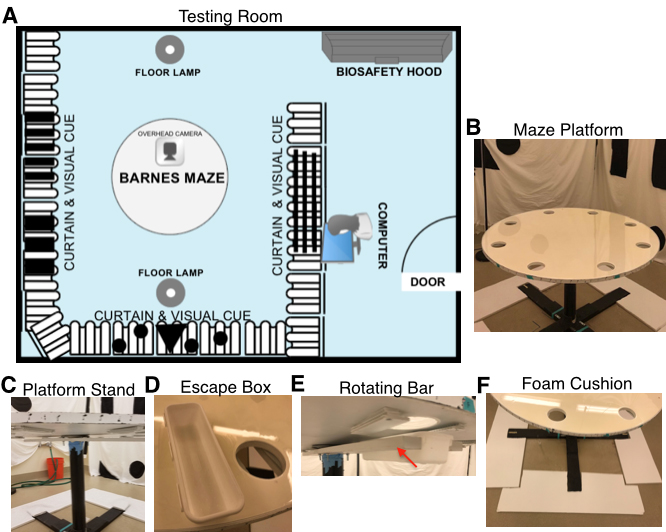
Figure 1. Experimental setup for Barnes maze adapted for juvenile animals. A. Arrangement of behavioral testing room and analysis room. B-F. Images of adapted Barnes maze platform (B), PVC platform stand with wooden base (C), PVC escape box (D), rotating bar for escape box (E), foam cushion for potential falls (F). - White curtains with distinct patterns made of large geometric shapes to create four walls of visual cues around the maze, as well as keep the experimenter hidden during testing (Figure 2)
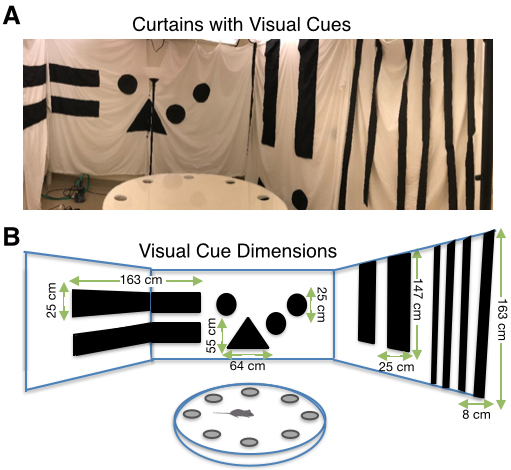
Figure 2. Visual Cues for Barnes maze adapted for juvenile animals. A. White curtains with enlarged visual cues. B. Dimensions of visual cues from right to left: horizontal rectangle (163 x 25 cm), triangle (base = 55 cm, height = 64 cm), circles (diameter = 25 cm), vertical rectangle (25 x 147 cm), stripes (8 x 163 cm). - Overhead camera (1/3" CCD, 30 frames/s, Panasonic, model: WV-CP280-N)
- PC computer
- Stopwatch
Software
- Video software (ULead Video Studio, Corel)
- TopScan Version 2.00, CleverSys
- Microsoft Excel
Procedure
文章信息
版权信息
© 2018 The Authors; exclusive licensee Bio-protocol LLC.
如何引用
Valibeigi, N., McHail, D. G., Kimball, C. L. and Dumas, T. C. (2018). A Modified Barnes Maze for Juvenile Rats. Bio-protocol 8(22): e3084. DOI: 10.21769/BioProtoc.3084.
分类
神经科学 > 行为神经科学 > 学习和记忆
神经科学 > 发育 > 空间导航
您对这篇实验方法有问题吗?
在此处发布您的问题,我们将邀请本文作者来回答。同时,我们会将您的问题发布到Bio-protocol Exchange,以便寻求社区成员的帮助。
Share
Bluesky
X
Copy link


